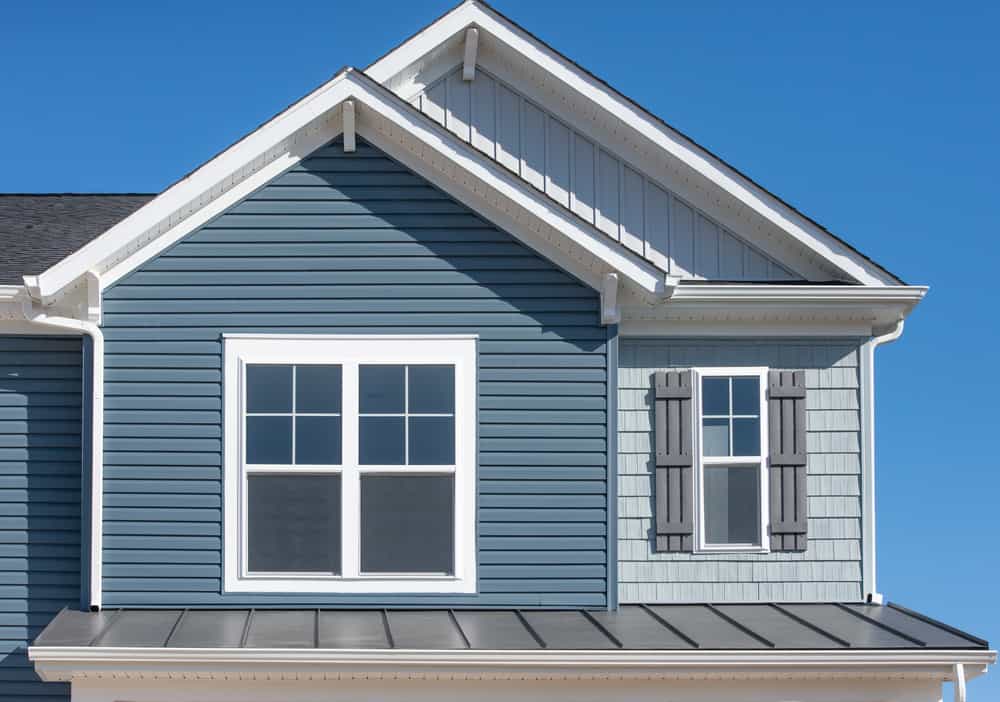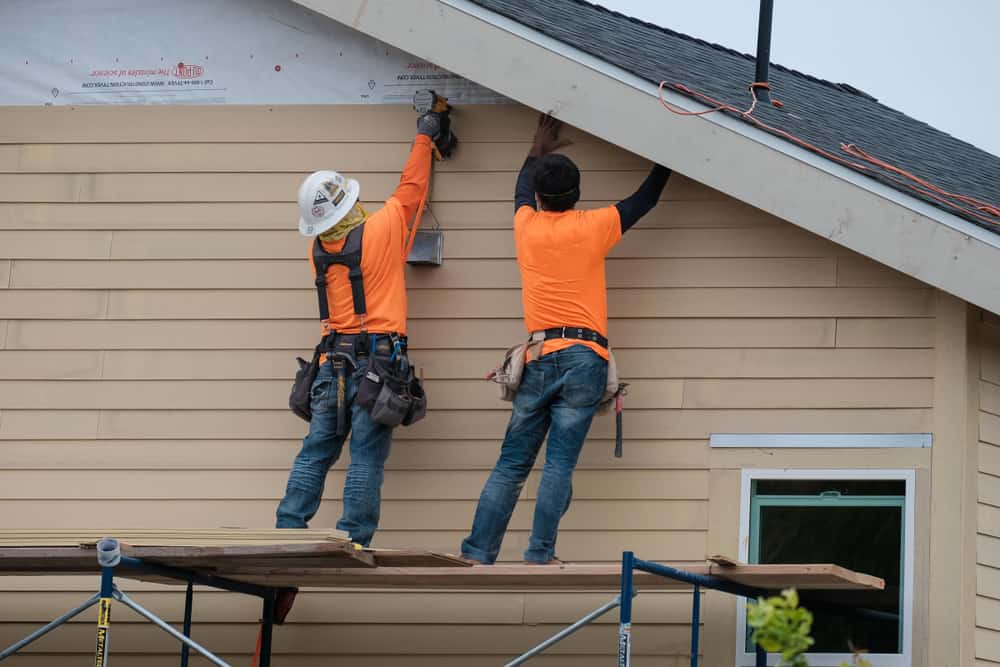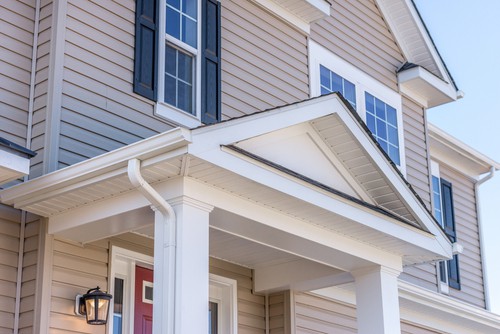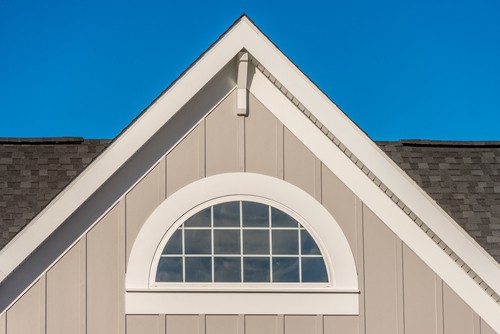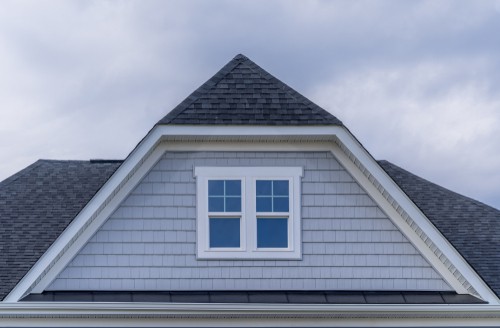Vinyl siding is an excellent exterior cladding solution for homes. Not only does it protect your house against harsh weather but also adds curb appeal that helps boost its value.
You have probably seen it on homes all over your neighborhood, or perhaps you just had it installed on your house, but have you ever asked yourself, “What is vinyl siding made of?”
Well, we were curious to find that out too, so we did some research and put everything in this article. Keep reading.
Table of Contents
What Exactly Is Vinyl Siding and Why Is It So Common?
Vinyl siding is a long-lasting plastic exterior wrapping for houses. It is primarily used for weatherproofing and enhancing the appearance of the house.
There are many reasons why homeowners prefer this material to other products used for siding like hardwood. For starters, it weathers harsh elements well. Vinyl siding is not prone to decay or insect and termite damage like wood is. It is also resistant to rust or other elements that ruin or affect the integrity of the traditional siding.
Additionally, vinyl siding does not need caulking or painting like other sidings. And once installed, it is very easy to maintain. The most you will be required to do is check the siding for any trapped moisture every so often and clean it every few years. And cleaning vinyl siding is very easy as you can see in this video.
If a panel is cracked or split, just remove it and install a new one. But this is something you will likely not have to deal with because vinyl siding is extremely resilient, sturdy, and durable.
What Is Vinyl Siding Made of?
Vinyl siding is solely made of polyvinyl chloride (PVC) resin and is usually designed and styled to look like natural wood siding.
It has two layers, (top and bottom layer), both made from different materials, although the key material is still PVC. The layers are joined together through extrusion. Extrusion is the process used to make many objects that have a cross-section profile, like a two-sided piece of vinyl siding.
During extrusion, the object is pushed through a predefined die of the cross-section. Vinyl siding usually goes through a continuous co-extrusion process.
What Materials Make the Top and Bottom Layer of the Siding?
The top layer (capstock) of the vinyl siding comprises 10% titanium dioxide and 90% vinyl. It takes up ¼ of the total thickness of the siding, and it is what gives the siding its color. This layer determines how dark or bright the final color of the siding will be.
The lower layer takes up ¾ of the total siding thickness. It is also referred to as the substrate and comprises 15% ground limestone (mainly calcium carbonate) and 85% vinyl resin. Limestone is used during the production of the siding to balance the titanium dioxide in the top layer so that both layers remain fluid throughout the process.
Other materials used in the extrusion include lubricants and tin mercaptan. The role of the tin mercaptan is to keep the siding stable throughout its lifespan. It is used in very small quantities.
Is Vinyl Siding Made to Withstand Harsh Weather?
Vinyl siding is commonly used in temperate regions like Texas, Florida, and California, where the weather does not go below freezing point frequently. Very low temperatures, (anything below 40° F) can make the siding weak, causing it to crack.
And while vinyl siding does expand when the temperatures rise, the heat of summer does not usually pose a problem as long as the installation was done properly.
However, if you plan to install your siding in the summer, consider hiring a person who is experienced in the job. Ideally, the panels should not be nailed down too tight, as this could cause them to buckle when the temperatures dip.
When vinyl siding is installed correctly, it can also withstand strong winds. It can easily hold up to wind speeds of up to 100 miles per hour without being blown off.
And because vinyl siding is made of PVC, which is a plastic material, you will not necessarily have to worry about water seeping in when it rains or when you pressure-wash the siding, as the water will flow right down to the ground, keeping the insulation behind the siding safe.
Types of Vinyl Siding
Over the years, vinyl manufactures have come up with ways to manipulate PVC into producing different styles and designs of house siding. Here are some of the types of vinyl siding you will find on the market today.
1. Horizontal Vinyl Siding
The horizontal panels are the most common type of vinyl siding. They are certainly not the most unique but ask any homeowner and they will tell you that these simple façades are timeless. Siding designs and tastes may have changed over time, but horizontal siding never gets old.
Plus it comes in a wide range of patterns, meaning, you can easily find a design that matches your style.
The only issue with horizontal siding is that it is more likely to let water into the interior wall. However, this is very rare.
You can prevent this problem by making sure the siding is installed properly and you are using high-quality insulation. The insulation will prevent any water that may have seeped through the siding from reaching the interior wall and causing mold or decay.
2. Vertical Vinyl Siding
The vertical siding was originally used for decorating barns and farmhouses, but thanks to the huge amounts of effort that has been put into sprucing up the rusty traditional designs, this siding is quickly gaining popularity both in residential and commercial spaces.
A house with vertical aiding is bound to attract the attention of anyone passing by, as it will stand out from the more common horizontal designs around the neighborhood.
Compared to the horizontal styles, however, vertical siding takes a little more time to install because it requires a bit of preparation work.
The most common vertical profiles are the board and batten, which combined together adds an elegant flair to the house. Most boards will usually be ten inches wide while the battens will be around two inches wide. They are mixed and matched to provide a twelve-inch wide siding profile.
3. Shake and Shingle Vinyl Siding
Some home designers love to use the authentic shake and shingle profiles on their siding. The shakes and shingles are usually arranged in a vertical manner and come in a wide variety of designs including hand-splint, half-rounded, and staggered edges. You will find the majority of these styles on historic buildings, providing a distinctive, charming look.
How the Materials Used to Make Vinyl Siding Affects the Environment
As stated, the foundation material in viny siding is PVC, and during the manufacturing process, this material produces greenhouse gases like nitrogen oxide and carcinogens such as dioxin, which have been found to have adverse environmental and health effects.
Greenhouse gases warm the air and the earth’s surface, which results in climate change and they also cause smog and air pollution that contributes to respiratory illnesses. Similarly, carcinogens alter cellular metabolism and damage DNA in cells, increasing the risk of cancer.
Another product released to the atmosphere through the manufacture of vinyl siding is sulfur dioxide that contributes to acid rain and smog.
The unfortunate thing about all of this is that the release of these toxic substances does not end in the manufacturing phase. Even after the vinyl siding has been installed, it continues to off-gas and emits harmful chemicals, though in small quantities.
Studies are still being conducted as to whether installing vinyl siding in homes exposes the owners to health problems. However, if a house catches fire, high levels of dangerous chemical vapors are released. Inhaling these fumes is actually what causes most deaths in house fires.
So, Why Is Vinyl Siding Still Being Produced?
Sure, the manufacturing process of vinyl siding poses a great danger both to humans and to the environment, but it typically consumes far less fuel, energy, and water than the production of brick and mortar or fiber cement.
Also, vinyl panels can easily be reground and remolded, meaning, very little material goes to waste. If you remove old vinyl siding and install a new one and the old one is still in good shape, you could still reuse it in other home projects or take it to your nearest construction reuse center where it can be used by other homeowners.
The Takeaway
While there are other materials used to make vinyl siding, PVC takes the largest percentage. Today’s vinyl siding comes in different styles and designs to match every homeowner’s needs and is sturdy enough to withstand harsh weather.
Although there are some concerns about the adverse effects of the production of vinyl siding on humans and the environment, manufacturing vinyl is still more efficient than producing brick and mortar, as it uses far fewer resources. Plus the siding can be reused and recycled, which makes it more sustainable.
